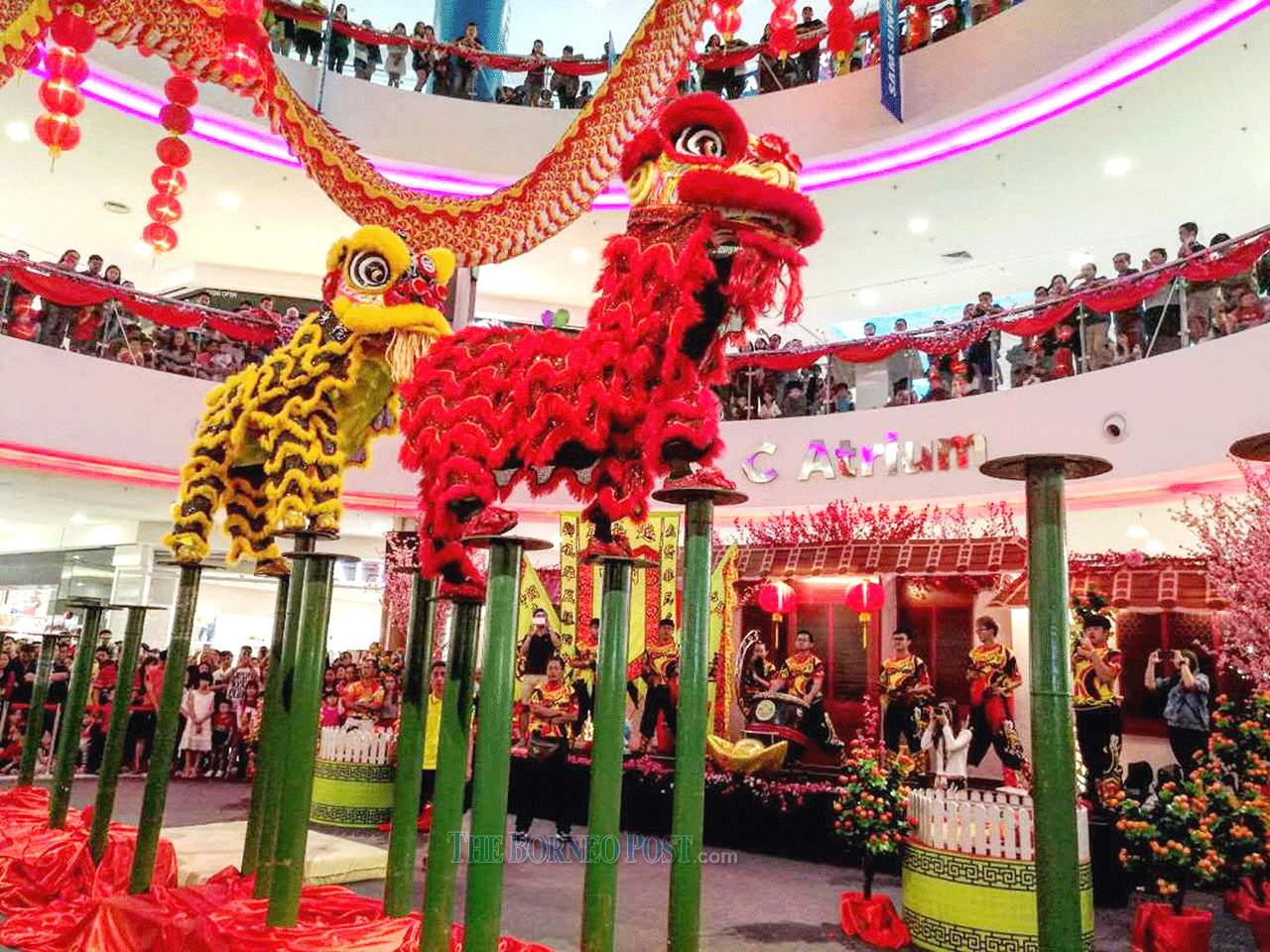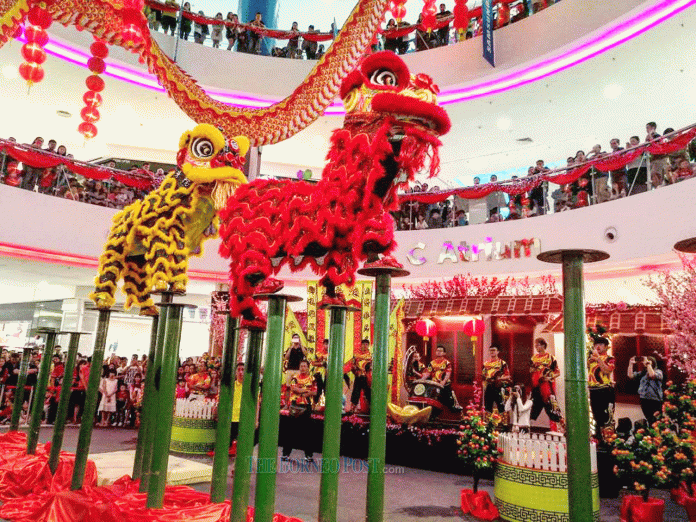
The CMAA Lion Dance Troupe performs an aerobatic high pole lion dance at a shopping mall in Kuching.
CHINESE New Year has always been the busiest time of the year for Nelson Nguang.
The Chinese Martial Art Association (CMAA) Dragon and Lion Dance Troupe chief coach would usually oversee preparations for his dragon and lion dance activities as the Lunar New Year approaches.
However, ushering in the Year of the Ox will be a quieter, if not stay-home, affair for Nguang and his troupe as Covid-19 has pretty much cancelled this year’s celebration.
“The CMAA Dragon and Lion Dance Troupe usually receives between 70 and 80 reservations during Chinese New Year, including bookings for performances at shopping malls around Kuching.
“But this year will be the first in my 36 years in the business that Chinese New Year is being held without a single lion or dragon dance performance.
“Without doubt, we all feel very disappointed but have no choice because the health of our troupe members and students and the public is our primary concern,” he told thesundaypost.

Nguang draws designs on one of the lion heads.
The 46-year-old always has a passion for the art of lion dancing, a centuries-old Chinese New Year tradition and an integral part of Chinese culture. He first laid eyes on the dazzling routines of a lion dance performance back in 1987, when he was still in secondary school and was instantly hooked.
“At that time, not many parents allowed their children to join a lion dance troupe because they believed lion dancing might inculcate bad habits and attitude in children. My parents also thought the same,” he said.
Misconception
In the old days, there was a misconception that lion dance troupes were associated with gangsters and riffraff, despite the dance itself being performed to bring prosperity, good fortune, and drive away evil spirits.
But Nguang has a strong appreciation for this art form and always believes such a Chinese cultural tradition must be preserved for posterity.
“So, without my parents’ approval, I went ahead and joined the CMAA Dragon and Lion Dance Troupe that same year as a member,” he chuckled.
Picking up a new skill is always hard in the beginning but Nguang’s tenacity allowed him to master the art of lion dancing.

The frame of the lion head is made of bamboo materials.
“Together with other students in the troupe, we had to learn every movement and step. For instance, we must be able to convey the emotions of the lion during the performance such as happiness, anger, sadness, and so on while working in sync with our partners to mimic the movement of the beast,” he said.
Two categories
According to him, there are two categories of the lion dance – traditional and aerobatic high-pole.
“The traditional one normally takes two years to master and it’s not easy because every step and movement must look realistic. What’s most important is that those watching the performance know what the lion is doing.
“As for aerobatic high-pole, it takes about three to four years to master. This type of performance focuses more on acrobatic stunts and the performers need more time to train to get it right,” he explained.
Under CMAA, Nguang had the opportunity to participate in many events over the years, including lion dance skill cultural exchanges as well as national and international competitions.
“I’ve especially fond memories of the competitions because they developed my social and life skills and enabled me to learn the true meaning of team spirit.
“We trained hard for the competitions and even though we may have had differences of opinion and some misunderstandings, we still tried our best to solve problems as a team, perform well, and emerge as champions,” he said.

The CMAA Lion Dance Troupe with the committee and advisors after an eye-dotting ceremony.
Coaching certification
In 2000, Nguang decided to go for certification as a dragon and lion dance coach to impart his skills and knowledge to the younger generation.
“I took up a course, organised by the Dragon and Lion Dance Federation of Asia and Malaysia Dragon and Lion Dance Federation, and became a certified dragon and lion dance coach and international dragon and lion dance judge,” he said.
Moreover, he holds several other prominent posts, including CMAA Dragon and Lion Dance Troupe treasurer, Sarawak Dragon-Lion Dance and Wushu Association technical director, as well as Malaysia Dragon and Lion Dance Federation Technical Department Northern Lion assistant director.
He said the CMAA Dragon and Lion Dance Troupe now has around 50 to 60 members – 85 per cent Chinese, 10 per cent Malay, and 5 per cent Dayak.
“Most of our members are students. We have also set up a Wushu and Dragon-Lion Dance Club in the schools. It’s from there that we can scout for talents and train them at the elite centre.”
Though appreciation and awareness of Chinese culture among the younger generation might not be as strong as it used to be, Nguang is hopeful they will still connect with the long-standing tradition of lion dancing.

CMAA Lion Dance Troupe performs one of the lion dance routines to usher in the Lunar New Year.
“In the modern world, the newer generations are more interested in electronic gadgets and digital technology although I can’t say they will be totally uninterested in learning about the lion dance.
“It really depends on how they view the lion dance and it’s up to us to find creative ways to promote this time-honoured tradition not only as a performing art but also as a form of sports so that the younger generation will have a sense of appreciation for it,” he added.
Proactive approach
Nguang suggested one of the best ways to promote the lion dance is holding demonstrations and competitions or incorporating the activity into extra-curricular programmes.
“In this way, the students can talk and learn about the lion dance and make new friends at the same time.”
He pointed out that the Malaysia Dragon and Lion Dance Federation had played an active role in getting the dragon and lion dance recognised by the Ministry of Youth and Sports and the Education Ministry as a sports activity in schools.
“Today, we feel proud the dragon and lion dance is part of activities held in schools and also recognised as a sport.
“Hopefully, in the coming year, it can also be included as a new sport in the Sukma (Malaysia Games).”
According to Nguang, the dragon and lion dance has already been recognised as a sport in the Asian Indoor and Martial Arts Games with countries like China, Hong Kong, Macao, Singapore, Vietnam, Thailand, Indonesia, and Malaysia participating in this pan-continental multi-sports event.
Lion costumes
Nguang has also mastered the art of making the lion costumes.
He started by learning to make the lion head and would observe his sifu (master) at CMAA doing it before trying to make one himself.
“At first, the result was not very satisfactory – it didn’t look like a lion at all. I didn’t give up but kept practising until I got it done perfectly.

A dragon dance performance by CMAA during a parade for a deity.
“Initially, the lion costumes I made were mainly for my team’s use but in 1998, I decided to start a small business, selling them, and was very fortunate many of my friends from the lion dancing fraternity also supported me,” he recalled.
Nguang said the lion head is made mainly from materials such as bamboo, aluminium, masking tape, glue, and cloth of various colours.
“Once the framework is done, we need to draw the designs and come up with the colours for the lion head before fitting it with eyes, ears, mouth, and body, using sheep’s wool and rabbit fur as the final step.
“Normally, it takes about one week to finish the whole set of the costumes, including the lion head, body, and pants,” he said, adding that the price of a lion costume ranges from RM1,300 to RM2,500, depending on the quality.
As there will be no performances this Chinese New Year due to Covid-19 restrictions, Nguang said his team would be facing a shortage of funds to maintain their activities and training centre rent.
“This is the biggest challenge because most of our funds for our activities and rent come from well-wishers and supporters whenever we perform.
“Apart from lack of funds, we also have to reduce the training attendance of our students due to limited space and adherence to the standard operating procedures (SOPs).”
He pointed out that according to the SOPs, no close contact is allowed, no refreshments after training, no gatherings on weekends, and all lion dance equipment must be sanitised before and after training.
Although this Chinese New Year is more subdued, Nguang is optimistic things will return to normal eventually and dragon and lion dance performances will bounce back with much aplomb.
“I strongly believe if everyone follows the SOPs strictly and with the arrival of Covid-19 vaccines, the pandemic can be contained and life can go back to normal,” he said.
The post The lions take a rest in Year of the Ox appeared first on Borneo Post Online.


